![]()
![]()
![]()
Use LEFT and RIGHT arrow keys to navigate between flashcards;
Use UP and DOWN arrow keys to flip the card;
H to show hint;
A reads text to speech;
43 Cards in this Set
- Front
- Back
- 3rd side (hint)
|
Cardiovascular System |
Delivers oxygen and nutrients to the body tissues and carries away wastes such as carbon dioxide via blood Its major function is transportation |
|
|
|
Medial section of the Thoracic cavity between the lungs (inferior mediastinum) Pointed apex directed toward hip |
Where is the heart located? |
|
|
|
Apical pulse and 5th intercostal space |
Where one would place a stethoscope to count the rate of the? |
|
|
|
Pericardium |
Enclosed by a sac called _________? And is made up of three layers (outer fibrous layer and inner serous membrane pair) |

|
|
|
Fibrous pericardium |
Loosely fitting superficial party of the pericardium sac.
|

|
|
|
Fibrous layer |
Help protect the heart and anchors it towards surrounding structures such as the diaphragm and sternum |
|
|
|
Serous pericardium |
Deep to the fibrous pericardium is the slippery two layered ? |
|
|
|
Parietal pericardium |
Parietal layer of the serous pericardium that lines the interior of the fibrous pericardium |
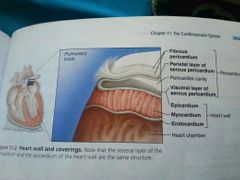
|
|
|
Visceral pericardium/layer of the serous membrane or EPICARDIUM |
Layer and part of the heart wall and is the innermost layer of the pericardium and the outermost layer of the heart wall. |
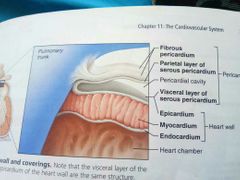
|
|
|
Serous pericardial membranes |
Serous fluid is produced by and collects in the pericardial cavity between the serous layers. Fluids allow the heart to beat easily in a relatively frictionless environment as the serous pericardial layers slide smoothly across each other |
|
|
|
Myocardium |
Consist of thick bundles of cardiac muscles twisted whorled into ringlike arrangements. Layer that contracts. Myocardial cells are link together by intercalated disc(contains desmosomes and gap junctions) |
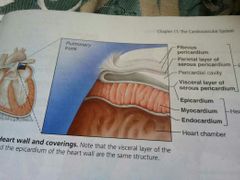
|
|
|
Skeleton of the heart |
Myocardium reinforced by dense fibrous connective tissue called |
|
|
|
Endocardium |
Thin, glistening sheet of endothelium that lines the heart chambers. Continuous with the linings of the blood vessels leaving and entering the heart. |
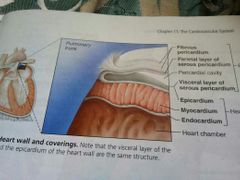
|
|
|
4; two atria (singular:atrium) and two ventricles |
How many and what are the chambers of the heart? These are lined by an endocardium (helps blood flow smoothly) |
|
|
|
Superior atria |
Receiving chambers and don't do pump activity Assist with filling the ventricles |
|
|
|
Inferior thick walled ventricles |
Discharging chambers and the actual pumps of the heart |
|
|
|
Hearts anterior surface |
What does the right ventricle forms the most? |
|
|
|
Its apex |
What does the left ventricle form? |
|
|
|
Interatrial septum (seperates atria) |
Septum that divides the heart longitudinally where it divides the atria interventricular septum (seperates ventricles) |
|
|
|
Arteries |
Carrying blood away from heart |
|
|
|
Veins |
Carry blood toward the heart |
|
|
|
Right side of the heart |
Works as the pulmonary cicrcuit pump. Reveives oxygen poor blood from the veins of the body through the superior and inferior vena cava |
|
|
|
Pulmonary trunk: Right and left pulmonary arteries (singular:artery) |

Where does the Oxygen poor blood coming from the veins of the venae cavae going to the right ventricle pumps out? |
|
|
|
(4) pulmonary veins |
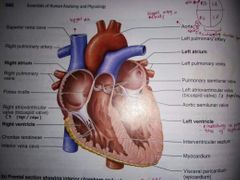
The pulmonary arteries which carry blood to the lungs (blood pick up oxygen and CO² unloaded or released) oxygen rich blood drains from the lungs and is returned to the left side through? |
|
|
|
Pulmonary circulation |
Circuit from the right ventricle back to left atrium is called? Its only function is to carryblood to the lungs for gas exchange (O enters blood and CO² enters lungs ) and then return to the heart |
|
|
|
aorta |
Oxygen rich blood enters the left atrium flows to left ventricle and pumped out to , which systemic arteries supply all body tissues Largest artery of the body |
|
|
|
Systemic circulation |
A circuit from the left ventricle through body tissues and back to the right atrium |
|
|
|
Left ventricle |
Has thicker walls than the other ventricle because it pumps blood over the much longer systemic pathway through the body |
|
|
|
4 |
Heart is equipped with how many valves that allows blood to flow in only one direction through the heart chambers |
|
|
|
Atrioventricular valves (AV valve) |

1st set of valves Located between the atria and ventricles on each side Prevents backflow into atria when ventricles contract |
|
|
|
Mitral valve |
Left AV valve or the bicuspid valve is also know as that consists of two flaps or cusps of endocardium. |
|
|
|
Tricuspid valve |
The right AV valve also known as? Has three cusps and has tiny white chords (chordae tendineae) or tendinous chords more of like heart strings |
|
|
|
Chordae tindeneae |
Anchors the cusps to the walls of the ventricles |
|
|
|
Semilunar valves |
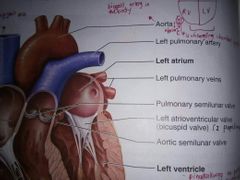
Guards the bases of the two large arteries leaving the ventricular chambers. These are known as pulmonary semilunar valve and aortic semilunar valve and has three cusps Prevents arterial blood reentering the heart |
|
|
|
AV valves |
what valves are open during heart relaxation and closed when the ventricles are contracting |
|
|
|
Semilunar valves |
Closed during heart relaxation and are forced open when the ventricles contract |
|
|
|
Gap junctions |
Allows ions to flow from cell to cell. Wave of Excitement across the heart |
|
|
|
Cardiac cycle |
Event of one complete heartbeat |
|
|
|
Heart murmurs |
Abnormal or unusual heart sounds, blood flow becomes turbulent and created sounds |
|
|
|
Coronary atherosclerosis |
Clogging of the coronary vessels with fatty buildup |
|
|
|
congestive heart failure |
Pumping efficiency of the heart is reduced so that circulation is inadequate to meet tissue needs |
|
|
|
pulmonary congestion |
Pumping of the left heart fails |
|
|
|
Tunica intima |
Lines the lumen or interior of the vessels, is a thin layer of endothelium resting on a basement membrane |
|

